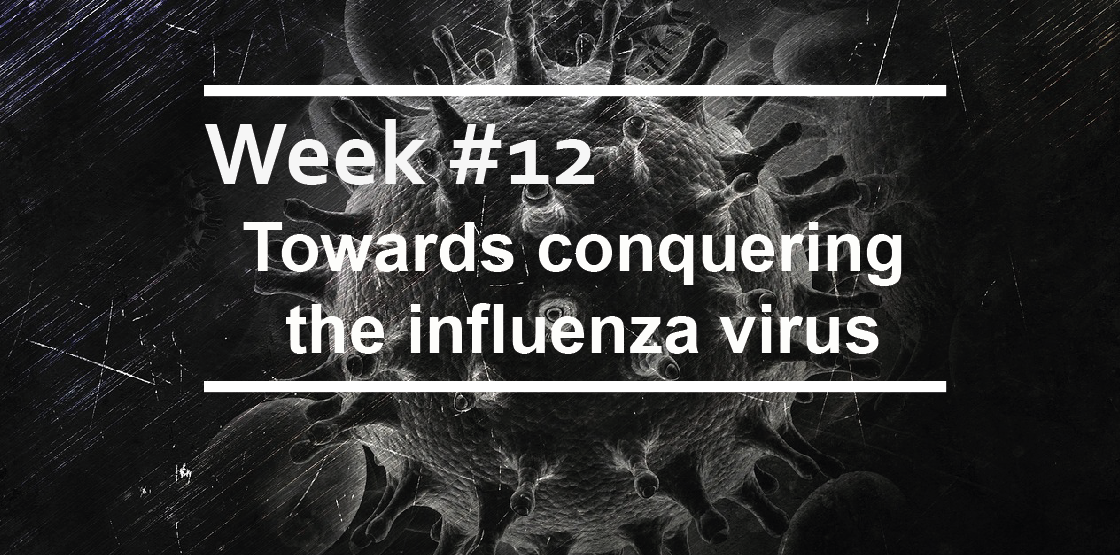Towards conquering the influenza virus
This week we walk through a relevant short editorial by Gail Teitzel entitled “The Moving Target of Flu” that highlights some interesting approaches to vaccine design and optimization.
Annually, influenza virus infects millions of people worldwide. Because of the high rates of mutation and reassortment characteristic of viral RNA genomes, the circulating populations of influenza viruses are constantly changing and rapidly evolving. In fact, it might help to think of viruses as a dynamic population of numerous variants that undergo selective pressure. Due to this high mutation rate, the production of an optimal influenza vaccine requires constant global monitoring of the current circulating strain so that, for each new flu season, vaccine manufacturers can reformulate their product. Once that the seasonal strains have been identified, the virus is grown in egg- or cell-based systems and vaccines are created to induce an immune response, which will hopefully prevent viral entry.
A small change, a big difference
Influenza vaccines aim to elicit the production of antibodies against hemagglutinin (HA), a surface protein that covers the viral capsid and binds the receptor of potential host cells to mediate viral entry. The generation of these antibodies prevents subsequent reinfection with the same strain. In addition to the difficulty of predicting the seasonal influenza strain, vaccine producers must also avoid unwanted antigenic modifications in the process of viral growth for vaccine production. The low vaccine efficacy seen in 2016–2017 was caused by such unwanted antigenic modifications during the production stage. The circulating H3N2 strain grew poorly in chicken eggs, requiring the use of an egg-adapted H3N2 sub-strain carrying a threonine to lysine mutation in the HA protein. This small change was enough to make the vaccine antigenically different from the circulating strain, influencing the effectiveness of the vaccine. As an alternative to egg-based systems, cell-based flu vaccines are now being developed, with some already approved for use in the US and some European countries.
Calibrating the potency of the vaccine
Another way to improve the efficacy of influenza vaccines is to attenuate the virus to increase the immune response. The type I interferon (IFN) response plays a major role in the defense against viral infection. Influenza viruses use multiple mechanisms to attenuate the IFN response, thus being able to infect their target hosts: the nonstructural protein NS1 is the best characterized IFN modulator. Recently, a high-throughput genomics method has been developed to identify point mutations that confer IFN sensitivity in the viral sequence. Using this information, it was possible to create a vaccine capable of inducing a rapid and strong immune response with increased expression of IFN-stimulated genes.
The quest for a universal vaccine
While incremental improvements in the production of seasonal vaccines will continue to be made, ideally, a single universal vaccine against influenza should be developed. Theoretically this could be done by targeting conserved or least variable regions of HA to create antigens that would be able to broadly recognize and neutralize a wide set of influenza strains. While several efforts are currently being made, this editorial brings attention to Deng et al. (2018)’s double-layered protein nanoparticle approach, which combines a tetramer of the influenza matrix protein 2 ectodomain (M2e) (in the core of the protein nanoparticle) with headless hemagglutinin sequences (coating the core of the nanoparticles). Vaccination of mice using these protein nanoparticles induced a robust immune response and increased survival upon subsequent infection with a range of influenza A strains, including avian strains with pandemic potential.
These are just some of the exciting approaches that are under investigation in our attempts to control the seasonal influenza burden and prepare for potential pandemics.




